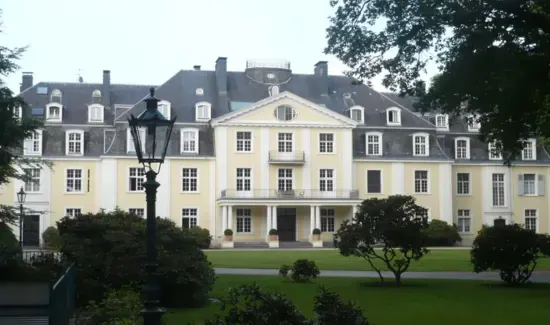

Place of interest "Meerbusch"
Haus Meer
Right on the B 222 you will find the tea house, which is often called a " landmark Meerbusch ". At a corner of the former palace grounds of "Haus Meer". The premonstratensian abbey founded in 1166 by "Countess Hildegunde of Meer" was used after the secularization in 1804 by the Krefeld silk weaving family "von der Leyen" as a family castle. The main building that was destroyed in the Second World War, was retained in addition to the tea pavilion of the former estate. This is inhabited and used commercially. The development of the historic area has been in operation since 1974.
Dyckhof
The Dyckhof in Buederich is a castle that was first mentioned in 1393. The Baroque spire was added in 1666 . The former farm is used as a hotel and restaurant.
Old Church Tower
The old church tower became a memorial to the victims of the World Wars in 1959. It belonged to the parish church of St. Mauritius that was built in about 1200, the main building was destroyed by fire in 1891 . The Council of the former municipality of Buederich decided to award the contract for the memorial to the, then relatively unknown, artist Joseph Beuys. He created a sculpture for the tower , that someone remarked was a " symbol of the resurrection." This sculpture hangs on a long iron chain and takes up the shape of the cross. The sculpture made of oak wood is 3 meters high and 2 meters wide and hangs on the left side wall of the tower , so that the viewer's gaze , peering through the door opening does not fall directly on the sculpture . The double-leaf gate was made of heavy oak planks. The names of 222 Büdericher war deads are engraved in the right wing.
EUROGA Kunstweg
The EUROGA Art Trail was established on the occasion of the European garden show EUROGA 2002 plus for the Meerbusch city. The trail goes from the Titel Mataré and his students through Buederich, to 17 works of art that come from Ewald Mataré and some of his students. The trail begins in a park with sculptures of Bank of Heerich and Windsbraut by Karl Link. It leads through the cemetery of Buederich , which is part of the art path. Here, next to the memorial of Peter Rübsam you will find two gravestones created by Ewald Mataré as well as one by Joseph Beuys (for the family of Dr. Fritz Niehaus , the father of Ruth Niehaus ).
Heerich and Karl Franke designed tomb . The outstanding work of art path is undoubtedly the fine memorial in the old Church Tower, dedicated in 1959 to the dead of the two World Wars, designed by Joseph Beuys. It consists of the doors designed by Beuys with the names of the dead and symbol of the resurrection inside the tower . On Landsknecht, is the Matare Fountain, built posthumously to a design from the 1930s. A sculpture by Wolf Spemann and doors designed by Hermann Focke can be seen at the Bethlehem Church. On the route to the Mauritius Church, you will find the Karl- Josef Matthew Winters sculpture with the child .
Presented at the opening were 15 works of art supplemented by the former grave stone of the tomb of Karl Franke Mataré 2004. Also in 2005 the grave stone of Heerich of 1949 was made public .
Lank- Latum
In Lank- Latum District Built in 1912, the water tower falls on a bright steel construction. The tower was built by the West German Celluloidwerken , the factory was closed in 1985 and later demolished . The Lankans Teloy - mill was built in 1822 and operated until 1912. After a renovation in 1981 , the mill in the factory wing was completely restored and are used as an exhibition space and venue . The forest mountain , a terminal moraine of the last glaciation on the outskirts to Nierst , is a natural monument and one of the highest natural elevations of Meerbusch. Legendary is the story of the robbers , the Fetzer ,said to have hidden his treasure in the mountain forest, according to folklore.
Osterath
The Osterather station was built around 1850. It lies on the left side track of the Rhine and shows bright wood paneling on the facade.
The Osterather mill was first operated in late 1883 with wind and steam power. The sculptor, Will Howler, renovated the mill and uses it as a living and working space .
In 1981 the Elektrothek Osterath opened in a former round control building on a part of the RWE substation . The museum displays exhibits from a hundred years of high voltage engineering .
Ossum - Bösinghoven
The Chapel of St. Pancras with a central wing of the 11th Century is the oldest original surviving church in Meerbusch. In 1868 it was enlarged by the addition of a chancel and in 1911 with a bell tower .
In the immediate vicinity of Ossum - Bösinghoven is the listed castle Pesch and two protected mansions, Grip forest and Radong .
On the outskirts of Bösinghoven is also the Geismühle , a 700 year old tower windmill, although it formally belongs to Oppum .







